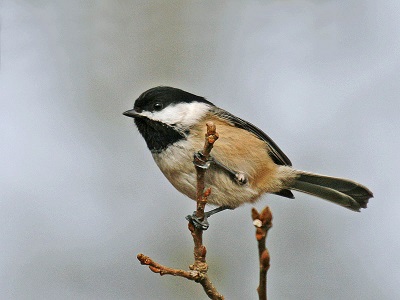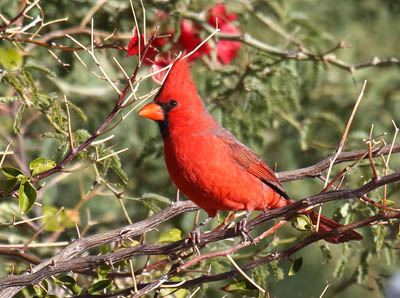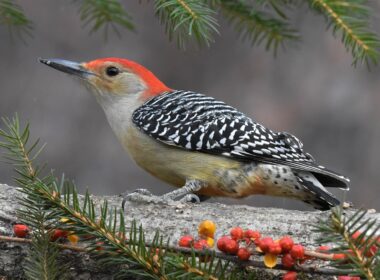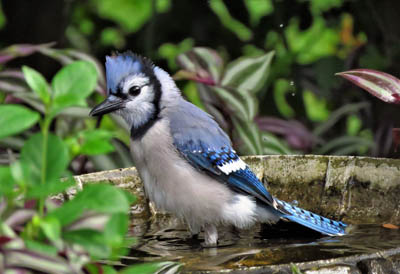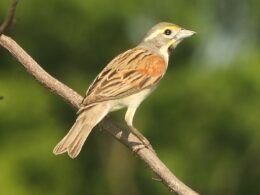Last Updated on January 24, 2024 by Greg Gillson
Did you see a brightly colored red bird, orange bird, or yellow bird in West Virginia and wonder what it was?
This page is for you!
This article shows you photos and identification of some of the most common birds in West Virginia based on color.
The list of birds found in West Virginia includes over 365 species. So, I can’t show you all of them. I’m going to assume that you saw a common bird of this color, but you certainly could have seen something less common, or even rare!
Shape (including the shape of the bill) and size are often more helpful in starting to identify a bird than the color. In fact, most birds in North American can be easily identified with a black-and-white photo!
Many birds are multi-colored, so that it may be hard to pick out a dominant color. Males and females may be colored quite differently. And some color patterns are similar among otherwise dissimilar species.
Nevertheless, I’m going to try to pick out some of the birds that you are most likely to see in backyards or towns. And I’ll show a few others that I get asked about a lot.
The birds with a noticeable amount of red on them in West Virginia covered in this article are:
- Northern Cardinal
- American Robin
- House Finch
- Ruby-throated Hummingbird
- Scarlet Tanager
The birds with a noticeable amount of orange on them in West Virginia covered in this article are:
- Eastern Towhee
- Barn Swallow
- Wood Thrush
- Brown Thrasher
- Red-shouldered Hawk
- American Redstart
- Baltimore Oriole
- Orchard Oriole
- American Kestrel
The birds with a noticeable amount of yellow on them, including lots of yellow and black birds, in West Virginia covered in this article are:
- American Goldfinch
- Northern Flicker
- Cedar Waxwing
- Common Yellowthroat
- Yellow-rumped Warbler
- Black-throated Green Warbler
- Eastern Meadowlark
- Yellow Warbler
- Hooded Warbler
- Yellow-throated Warbler
- Great Crested Flycatcher
- Yellow-throated Vireo
Red birds of West Virginia
Birds get the red, orange, and yellow in their feathers from carotenoids in the fruit, seeds, and plants they eat (source).
These carotenoid colors combine with melanin to form an infinite range of red feathers–pink, rusty, scarlet, violet, red-orange.
The following are red birds that you are most likely to see in West Virginia.
Northern Cardinal
These are one of the most common backyard birds in the eastern United States. Their bright red color and unique head profile makes them instantly identifiable to most people–whether they are bird watchers or not!
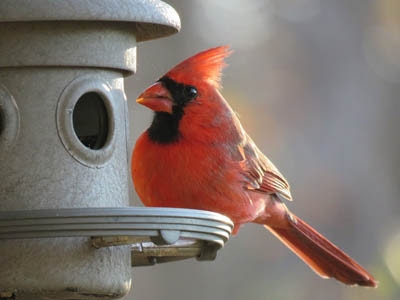 |
| Northern Cardinal. GeorgeB2 from Pixabay. |
Males of these large seed eaters are bright red with a black face and red crest.
Females replace most of the red with brown, The bill is large and orange.
These birds are found in woodlands, stream edges, residential areas.
Northern Cardinals are year-round residents throughout West Virginia.
American Robin
These are familiar lawn birds with red breasts.
 |
| American Robin. Greg Gillson. |
Male American Robins are brownish-gray above with a brick red breast. Females are paler orange below and paler gray above.
They are widespread in open country with scattered deciduous trees, residential areas.
American Robins are year-round residents throughout West Virginia.
House Finch
When people ask about a bird with a red head at their feeder, it is usually this bird.
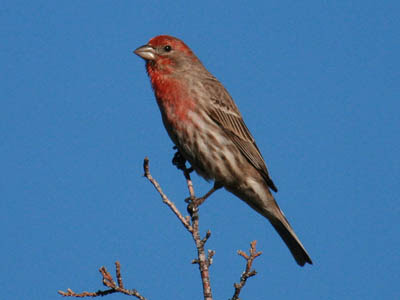 |
| Male House Finch. Greg Gillson. |
Males of this dusty brown striped finch have red limited to the head (specifically the forehead and eyebrow), breast (chest), and rump. The red coloration tends toward orangish and may rarely be yellowish.
Females are streaked, similar to the males but without red. They lack any strong pattern on the face and head.
Note the small round head and curved upper ridge on the bill.
Some people call these red-headed sparrows. Sparrows and finches are similar, but in general, male finches are brighter than the females and tend to hang out more in trees. Sparrow genders are usually quite similar in coloration and tend to feed mostly on the ground.
These birds are common in residential areas, especially at bird feeders. In the West more widespread in arid regions near water.
House Finches are year-round residents throughout West Virginia.
Ruby-throated Hummingbird
These red-throated birds are the only hummingbird nesting in the eastern United States.
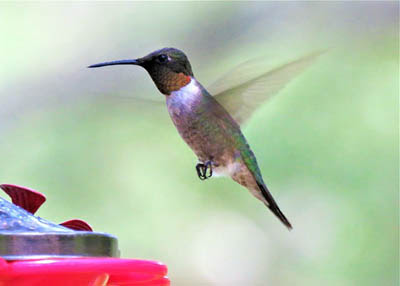 |
| Male Ruby-throated Hummingbird. GeorgeB2. Pixabay. |
Males are dark green above and on the belly. They have a white upper chest. The throat is ruby-red.
Females are green above, white below, including white throat.
These birds are found in woodland edges, residential yards. Readily come to hummingbird feeders.
Ruby-throated Hummingbirds are summer residents throughout West Virginia.
Scarlet Tanager
A brilliant red and black bird!
 |
| Male Scarlet Tanager. USF&WS. Public Domain. |
Males are unmistakable with brilliant red with black wings and tail.
Females are olive-green above, darker wings and tail, yellower under parts. Pale bill.
These birds live in deciduous woods.
Scarlet Tanagers are summer residents throughout West Virginia.
Orange birds of West Virginia
True orange-colored birds are not that common. Many birds that I have here are paler rusty.
The common pattern is an orange body and black or brown wings and tail. Another common pattern is for the orange to be restricted to the under parts.
The following are orange birds that you are most likely to see in West Virginia.
Eastern Towhee
These birds with rusty-orange sides like to hide in dense bushes.
 |
| Female Eastern Towhee. Skeeze. Pixabay. |
Males are black above with white wing patch, white tail corners. The sides are rusty. The belly white. Eyes variable: brown, red, orange, white, tending toward whiter southward.
Females are similar, but upper parts brown.
These birds are found in forest understory, dense brush, backyard hedges. Come to feeders.
Eastern Towhees are summer residents throughout West Virginia and year-round residents in southern Virginia.
Barn Swallow
These orange-bellied birds are a familiar sight across North America in summer.
 |
| Barn Swallow. Greg Gillson. |
These birds are purple-blue above with orange under parts and long forked tails. The color of the underparts in winter or on females are often cinnamon or buff-colored, but breeding males can be brighter orange-red.
These birds swoop low over fields and wetlands at lower elevations. They may build their mud nests in rafters on porches, garages, or other out-buildings.
Barn Swallows are summer residents throughout West Virginia.
Wood Thrush
These spotted birds with the orange-brown upper parts tend to hide in understory trees and on the forest floor.
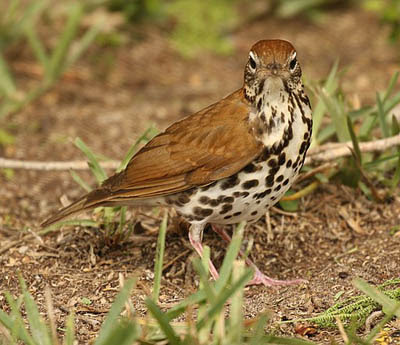 |
| Wood Thrush. Tony Castro. CC BY-SA 4.0 |
These birds are reddish brown on the upper parts, especially rusty orange on the crown and upper back. White eye ring. Large heavy black spots on the under parts.
They live in deciduous and mixed woods. Spend much time on the ground, shuffling through the leaf litter.
Wood Thrushes are summer residents throughout West Virginia.
Brown Thrasher
These are rather large rusty-orange songbirds.
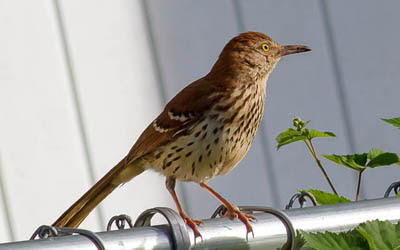 |
| Brown Thrasher. Linda Jones CC0. |
The upper parts of these birds are colored rusty-brown to orange. They show two white wing bars. Under parts are buff with heavy reddish-brown streaking.
These birds live in woodland edges and mature backyard landscaping.
Brown Thrashers are summer residents throughout West Virginia.
Red-shouldered Hawk
Okay, the shoulders are reddish. But the rusty-orange breast and wing linings are barred red too.
 |
| Red-shouldered Hawk. Greg Gillson. |
The upper parts are barred black and white. The tail is banded black and white. In adults the breast is barred orange.
Immature birds are streaked with brown on the breast.
These birds like woodland edges, residential edges, riparian groves.
Red-shouldered Hawks are summer residents throughout West Virginia and year-round residents throughout most of southern West Virginia.
American Redstart
In flight these small warblers flash orange or yellow in the wing and base of the tail.
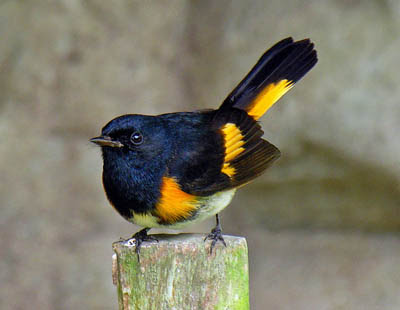 |
| American Redstart. Dennis Jarvis. Flikr. CC BY-SA 2.0 |
Males are black above, white on the belly. They have bright orange patches on side of breast, wings, and base of the tail.
Females are grayer, especially on the head. The orange of males is replaced by yellow on the females.
These birds are found in regenerating woods after a clear cut, and willow tangles along streams.
American Redstarts are summer residents throughout West Virginia.
Baltimore Oriole
These bright orange and black birds are fairly common breeders in wooded areas in the East.
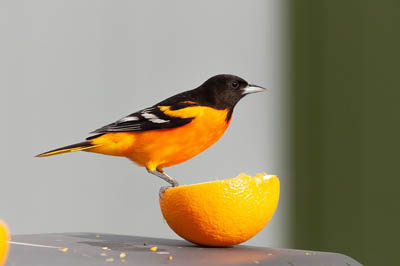 |
| Baltimore Oriole. Michael McGough. Pixabay. |
Males have a black hood and back. Wings black with white patches. Tail black with orange sides to the base. Bright orange under parts.
Females are similar to males, but more olive above, less black. Immature birds for their first year or more are olive above orangish-yellow on the breast, fading to yellow on the belly. Two white wing bars.
These birds are common in deciduous woods, shade trees.
Baltimore Orioles are summer residents throughout West Virginia.
Orchard Oriole
Males of these orioles are darker rustier-orange than most other orioles in the United States.
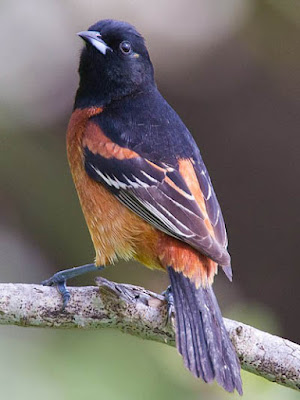 |
| Orchard Oriole. Dan Pancamo. Flikr. CC BY-SA 2.0 |
Males have a black hood and back, black wings and tail. The under parts are rusty-orange or even chestnut-brown.
Females are greenish above, lemon yellow below. They have 2 thin white wing bars. The bill is thinner than many other orioles.
They are found in orchards and residential shade trees.
Orchard Orioles are summer residents throughout West Virginia.
American Kestrel
These are the familiar small rusty-orange falcons sitting on power lines on the edge of the highway or hunting and hovering over the median strip.
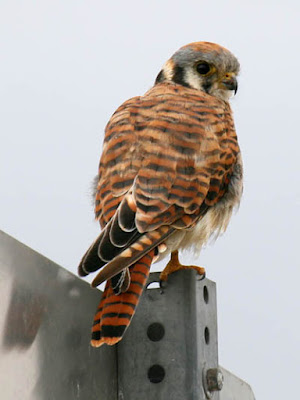 |
| Female American Kestrel. Greg Gillson. |
Females are rusty orange barred with black on their back wings and tail. The under parts are buff with black spots. The head shows two facial stripes.
Males have blue-gray backs and rufous tail is unmarked except for black tail band.
These birds are found in open country, farms, pastures with perches.
American Kestrels are year-round residents throughout West Virginia.
Yellow birds of West Virginia
Yellow is a common bird color! Often it is mixed with black and white plumage in birds.
Many birds with darker upper parts have yellow breast or belly.
The following are yellow birds you are most likely to see in West Virginia.
American Goldfinch
These small little birds are bright yellow and black.
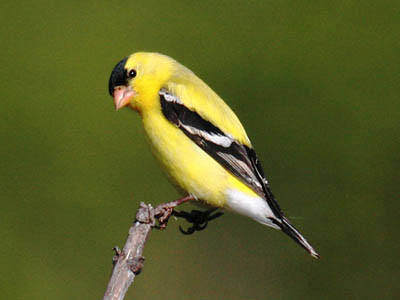 |
| American Goldfinch. Greg Gillson. |
Males are bright lemon yellow with black and white wings and tail, black cap. White under tail coverts. Pink bill.
Females are duller yellow below and brownish above. Lack black cap.
Winter birds are pale brown or gray, a touch of yellow on the throat of males.
These are birds of open country, fields with saplings, clear cuts, residential areas. They avoid dense forests, mountains, deserts. They visit feeders.
American Goldfinches are year-round residents throughout West Virginia.
Northern Flicker
These woodpeckers spend much time eating ants on the ground.
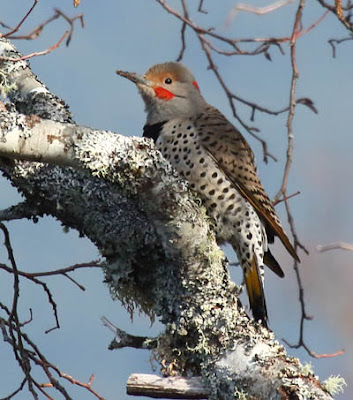 |
| Northern Flicker. Greg Gillson. |
These birds are larger than robins with brown and black barred upper parts. The underparts are pink with round black spots. There is a black crescent across the chest. When they fly away from you, they reveal a large white rump.
Western birds have salmon-red under wings and under tail. Those in the East are colored yellow. The male face differs between the two populations–black whisker on the eastern birds, red whisker on western birds. Intergrades from overlap on Great Plains common. These may show male facial characteristics of both populations, and yellow-orange flight feathers.
These birds live in open woods with bare ground for foraging, residential yards.
Northern Flickers are year-round residents throughout West Virginia.
Cedar Waxwing
These crested birds with yellow band on the end of the tail are often found in flocks. They eat flying insects in summer, fruit and berries the rest of the year.
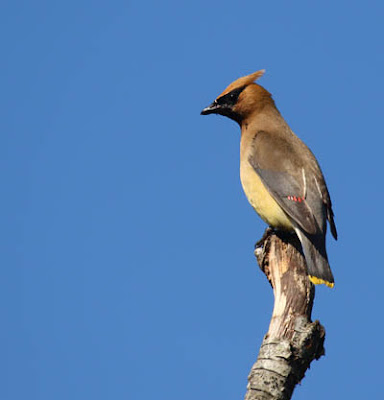 |
| Cedar Waxwing. Greg Gillson. |
These birds are fawn-brown above, with dark gray wings and tail. They have a black mask and wispy crest. The belly is yellow. The wings have waxy red drops on the end of the tertials. The end of the tail has a brilliant yellow tail band.
They are found in open habitats with berries, including juniper woodlands and towns in winter.
Cedar Waxwings are year-round residents throughout West Virginia.
Common Yellowthroat
These buttery yellow birds are abundant in the marsh vegetation.
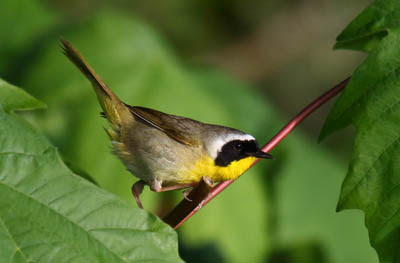 |
| Male Common Yellowthroat. Greg Gillson. |
These skulkers have bright yellow throats and yellow undertail coverts. Males have a black domino mask edged broadly in white, which females lack. Upperparts are dull olive-green.
Immature males in fall show a shadowed black mask.
Found in damp situations and heavy deciduous brambles following clear cuts.
Common Yellowthroats are summer residents throughout West Virginia.
Yellow-rumped Warbler
These are abundant warblers across North America. Affectionately called “butter butts” by many birders, because of their bright yellow rumps that flash in flight.
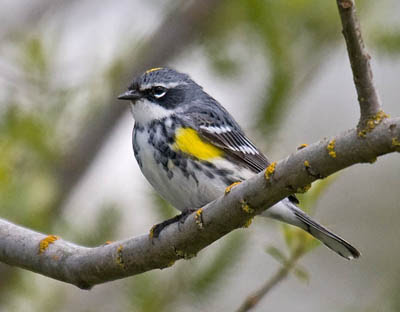 |
| Myrtle Yellow-rumped Warbler. Greg Gillson. |
Western form (Audubon’s) with bright yellow throat and yellow rump. Large white wing patch.
Northern and Eastern form (Myrtle) with white throat, yellow rump, and two white wing bars.
Winter birds are dull gray brown, with bright yellow rump. Throat may be cream colored or white. Often difficult to tell the two forms apart in winter.
 |
| Winter Yellow-rumped Warbler. Greg Gillson. |
Breed in mountain or boreal conifers. Widespread in migration. Winter in low river bottoms, open weedy deciduous areas. Rarely come to feeders in winter.
Yellow-rumped Warblers are winter visitors in western and northwestern West Virginia, spring and fall migrants only in eastern and southeastern West Virginia.
Black-throated Green Warbler
Look for these birds with the yellow faces singing high up in the trees in spring.
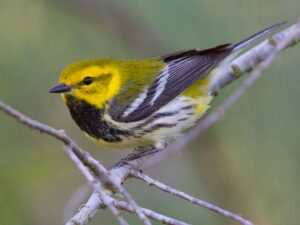
Males in spring have green back and crown, black throat, circling a bright yellow face.
Females and immatures in fall have a white throat. Greenish ear patch.
Found in many forest types, conifers, mixed forests, and cypress.
Black-throated Green Warblers are summer residents throughout West Virginia.
Eastern Meadowlark
These pale brown birds with the brilliant yellow breasts are home on the ground in prairies. They sing from perches on isolated trees, power poles, fence posts.
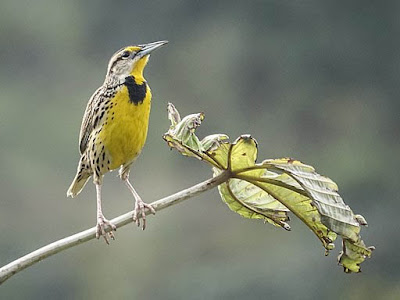 |
|
Eastern Meadowlark
Photo by Mike’s Birds from Riverside, CA, US [CC BY-SA 2.0]
|
The upper parts are streaked black, white, brown, so they blend into the dried grass where they live. The under parts are bright yellow with a black necklace across the chest. Very similar to Western Meadowlark, best told apart by spring song.
These birds live in prairies and extensive pasture lands.
Eastern Meadowlarks are year-round residents throughout most of West Virginia, summer residents inly in northern West Virginia.
Yellow Warbler
The golden yellow sun packed all into one little bird! Appears to be an all-yellow bird.
 |
| Yellow Warbler. Greg Gillson. |
Some populations are bright yellow, some tend toward greenish on upper parts, some more golden. Yellow internal tail corners in flight.
Males with red breast streaking, again, variable by population.
Females somewhat to much paler yellow, some greenish, some whitish. Lack red streaks.
These birds are found in willow thickets on the edge of wetlands and ditches, stream sides in arid regions.
Yellow Warblers are summer residents throughout West Virginia.
Hooded Warbler
These birds are found low down in the forest understory. They flash white tail corners.
 |
| Male Hooded Warbler. Christopher O’Toole. Pixabay. |
Males are dark green above with a black cowl over the crown and onto the throat. Face and under parts are bright yellow. White tail corners.
Females are similar but lack the black of the male. The crown is green and the throat yellow.
These birds are found in deciduous woods and swamps, primarily in brushy understory.
Hooded Warblers are summer residents throughout West Virginia.
Yellow-throated Warbler
These birds with the bright yellow throats creep along the branches high in trees.
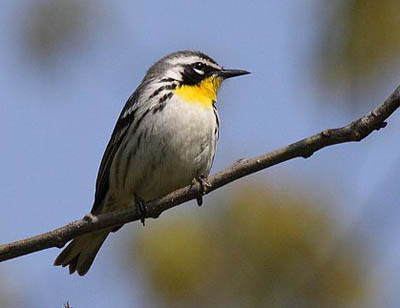 |
| Yellow-throated Warbler. Dominic Sherony. CC 2.0 |
These are rather gray warblers with bright yellow throat and upper breast. Black crown and face mask with white patch behind. White eyebrow. Two broad white wing bars. Black streaks on white breast and belly.
They like pine-oak woodlands, sycamores, cypress.
Yellow-throated Warblers are summer residents in central and western West Virginia.
Great Crested Flycatcher
These flycatchers have long tails and big heads with big bill and bright yellow belly.
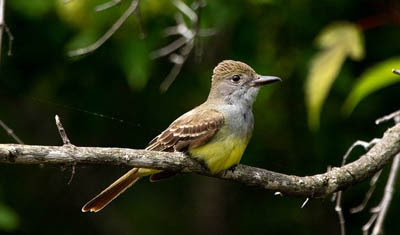 |
| Great Crested Flycatcher. Simard Francois. Pixabay. |
These birds are gray on the face and breast, brownish on rest of upper parts. Bright lemon-yellow belly. The under side of the tail and some feathers of the wing are cinnamon colored.
These birds stay in the canopy of open woods.
Great Crested Flycatchers are summer residents throughout West Virginia.
Yellow-throated Vireo
Vireos are slow moving small birds that sing throughout the day. These yellow-headed vireos are one of the most colorful of their clan.
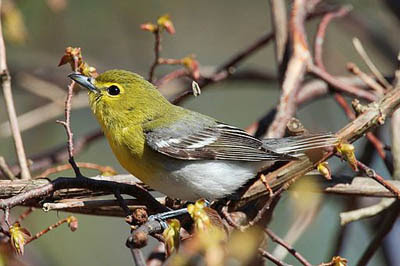 |
| Yellow-throated Vireo. MDF. CC BY-SA 3.0 |
These birds are blue-gray above, white below. Two white wing bars. Their head is olive yellow with yellow spectacles around the eye, and bright yellow throat.
These birds like large tracts of unbroken deciduous or mixed woodlands. Interestingly, however, they are often found on forest edges.
Yellow-throated Vireos are summer residents throughout West Virginia.
Wrapping Up
West Virginia is renowned for its rugged hills and rolling pastures. If you have seen enough colorful birds in your backyard and you want to explore further, there are many more bright birds to be found. Here are some of my favorites:
- Eastern Bluebird: This iconic songbird is a vibrant resident, with males boasting a sky-blue back, wings, tail, and head, contrasted by a reddish-orange chest and underside.
- Indigo Bunting: These small beauties flash electric blue plumage on their head, back, and wings, particularly striking in sunlight. Look for them in open fields and meadows.
- Blue-gray Gnatcatcher: As the name suggests, this tiny bird sports a blue-gray upper body and white underparts. They flit through trees and shrubs, capturing insects with their long bills.
- Great Blue Heron: This majestic wader isn’t fully blue, but its impressive size and slate-blue plumage with long legs and spear-like beak make it a memorable sight near water bodies.
- Eastern Wood-Pewee: This flycatcher has olive-green upperparts and pale underparts, often perching quietly on branches to wait for insects. Their sweet, melancholic song is a characteristic call of summer woodlands.
Frequently Asked Questions
What kind of bird has a red head in West Virginia?
The Western Tanager has a bright red head. Unfortunately, seeing one in West Virginia is improbable. While there are three tanager species found in the state, the Western Tanager is not one of them. Their breeding range is primarily confined to the western United States and Canada, from the Rocky Mountains to the Pacific coast.
However, you might be able to enjoy some other beautiful tanagers during your birdwatching adventures in West Virginia:
- Summer Tanager: The most common tanager in the state, males are a vibrant red with black wings and tail, while females are yellow. They typically inhabit deciduous forests and edges.
- Scarlet Tanager: Look for males with bright red plumage and black wings, while females are greenish-yellow. They prefer mature forests with tall trees.
- Eastern Bluebird: Though not technically a tanager, they share similar colors with males boasting a sky-blue back and wings, contrasting with a reddish-orange chest. They are common residents in open woodlands and fields.
While you may not encounter a Western Tanager, these other species offer their own charm and vibrant colors to add to your birding experience in West Virginia.
What is the bird that looks like a Robin but orange?
You are probably looking at a Varied Thrush. This bird has a similar size and shape to a robin, but its breast is a brighter orange-red, extending onto the back and wings. They also have a black eyeline and orange eyebrow stripe. They’re more common in the western US and Canada.
There have been only a handful of documented records of Varied Thrush in West Virginia, dating back decades and considered exceptional vagrant occurrences. So, the chances of encountering one during your birdwatching endeavors in the state are very slim.
How do I identify a yellow warbler?
Identifying a yellow warbler depends on several factors, including location, time of year, and the age and sex of the bird. Here are some key points to consider:
- Adult male: The most striking feature is their bright yellow plumage, almost like egg yolk, covering their entire body. They have chestnut streaks on their breast and flanks, which are most prominent in spring and summer.
- Adult female: Duller than the male, with olive-green upperparts and yellowish-green underparts. They lack the chestnut streaks but have a faint yellow wash on the breast and a yellow throat.
- Immatures: Similar to females but more streaked on the underparts and may have a brownish tinge to their plumage.
Related Articles:
Most common backyard birds in West Virginia
Birds with red heads in North America.
Yellow-and-black birds in North America.


